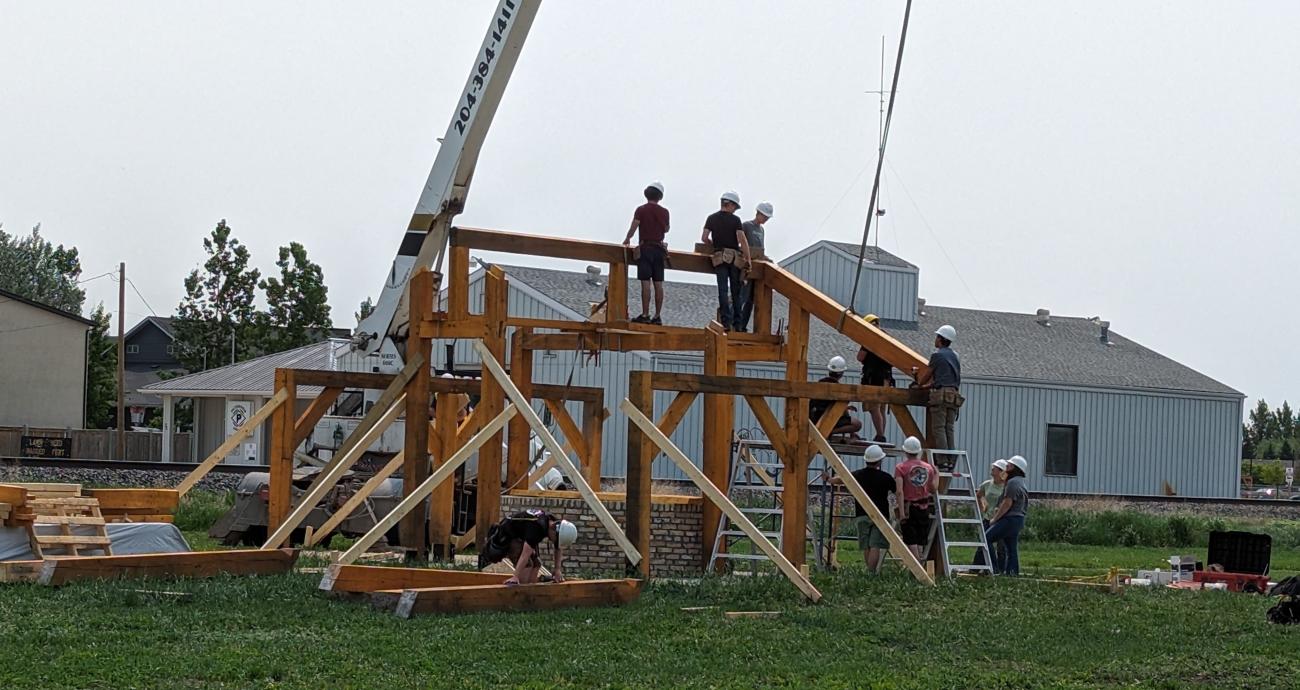A new timberframe structure stands proudly just to the west of the railway tracks in Niverville. Its purpose is to provide shelter over the historic CPR well.
The CPR Well Historical Park is a joint initiative of the Town of Niverville, Communities in Bloom, and local historian Ernie Braun. The goal is to pay homage to a key icon of Niverville’s history which was accidentally rediscovered a decade ago.
On May 30, ten construction students from the Steinbach Regional Secondary School (SRSS) stopped in to erect the final portion of the timberframe structure they built.
The student crew, along with their teacher Paul Wilson, have been busy for the past six to eight weeks planning, designing, drawing, and cutting the various components.
Out of Wilson’s 14 construction students, three are women.
A crane operator met the students onsite to put up the ridge and rafters, completing their portion of the build and readying it for roofers to finish the job.
“We try to do one of these [types of projects] a year,” Wilson says. “It has to be a public project. We don’t ever do work for [private] community members. It also has to be something that’s doable. It can’t be a huge project.”
Most of the projects these students are commissioned to do are for towns or municipalities in southeastern Manitoba. Last year, they built a ski hut in the Sandilands district.
History of the CPR Well
The CPR well holds deep historical relevance for Niverville, an agricultural town built around Manitoba’s first grain elevator and the railway that moved that grain.
Well over a century ago, during the epoch of the steam locomotive, Niverville was chosen as the first “tank station” for trains running along the Pembina Branch of the CPR between St. Boniface and St. Paul, Minnesota.
Steam-driven trains required water-refilling stations such as Niverville’s along their routes.
Niverville’s water filling station sat trackside very near a well that had been dug to keep the tank full and ready. Both were constructed in the 1880s. They served their economic purpose for nearly a century until the steam engine went out of use.
Sometime in the mid-twentieth century, Niverville’s tank was removed and the well covered up.
It wasn’t until 2012 that the well resurfaced when a town employee operating a tractor on the west side of the tracks tipped precariously into a sinkhole. When it was pulled from the cavity, the still-intact brick walls of the ancient well were revealed.
Braun is a member of the East Menn Historical Committee and co-author of the Historical Atlas of the East Reserve. He has been a key advocate for preserving the old well and telling its story.
“Niverville is one of the oldest urban service centres on the East Reserve,” Braun says. “But almost all the historical markers—like the elevator, the station houses, the various hotels, and now even the old Main Street store—are all gone.”
In an effort to preserve this relic and celebrate Niverville’s railway history, plans were developed to build a pocket park around it. Town staff have applied for grants, which are being invested into the park as money is received.
“The well site is a perfect place to create walking spaces, greenspace, and a commemorative site,” Braun says. “This site will interest the community for recreational reasons, but it will also interest the wider tourist population who will be passing through Niverville. It will be an opportunity to showcase our history.”


